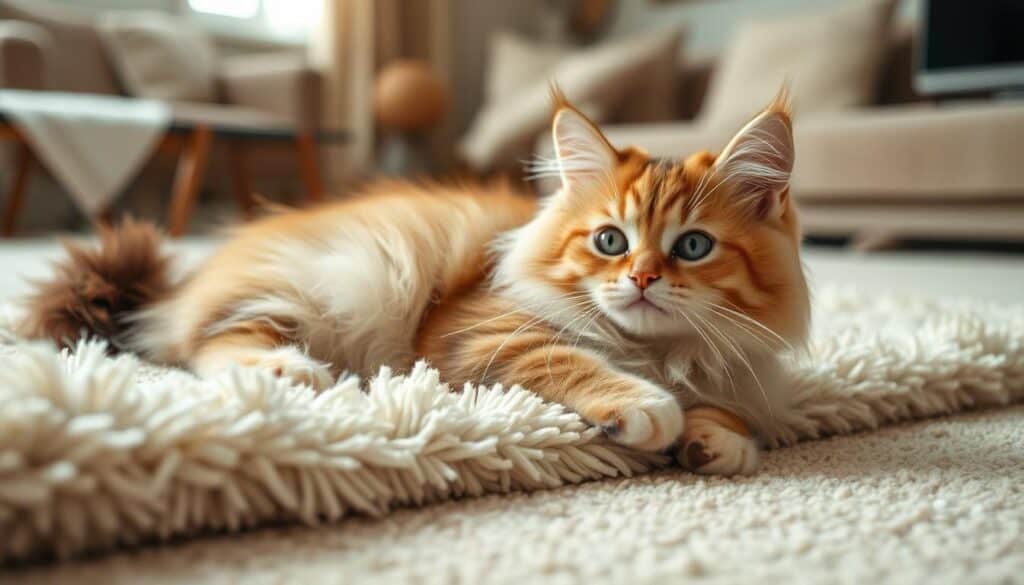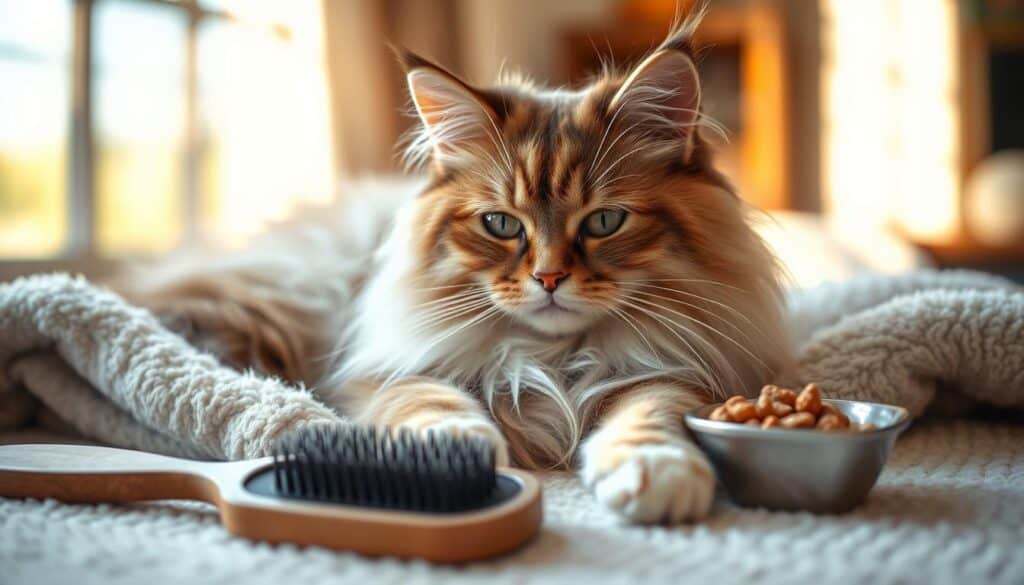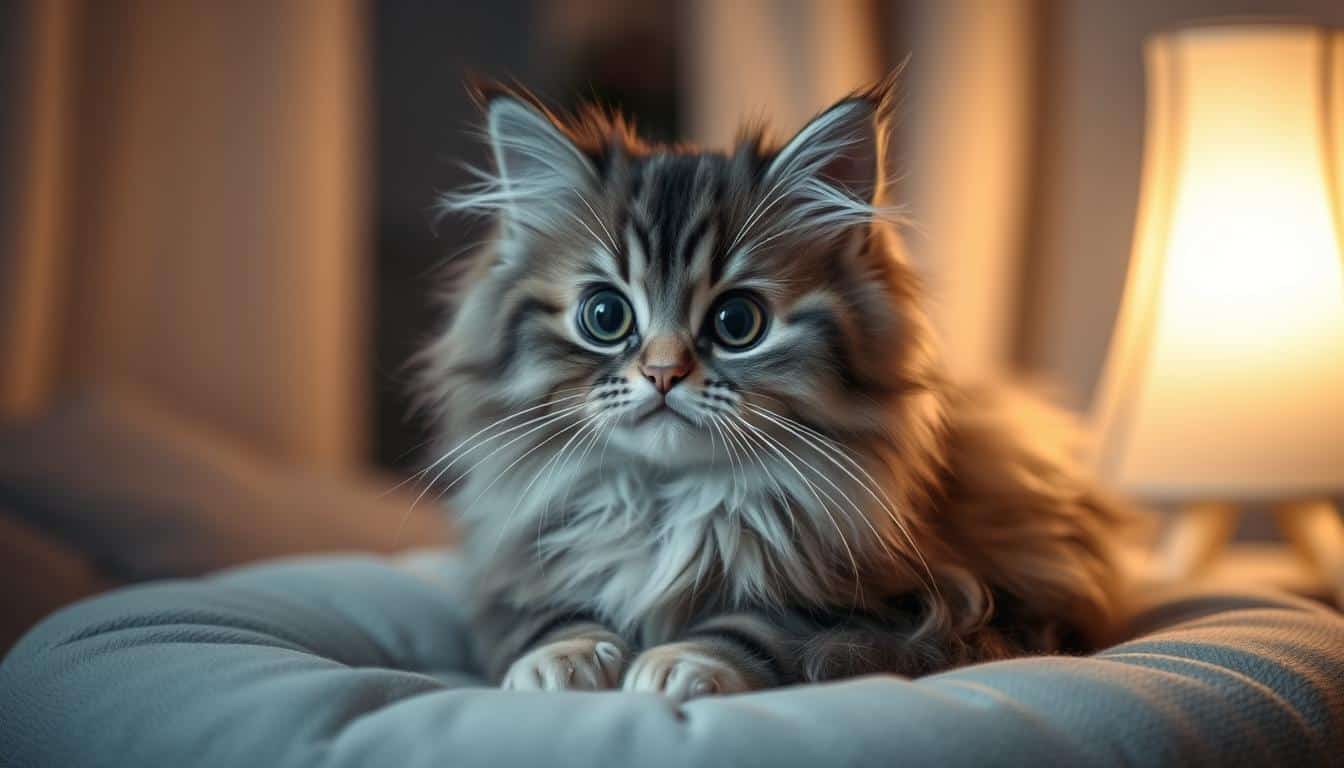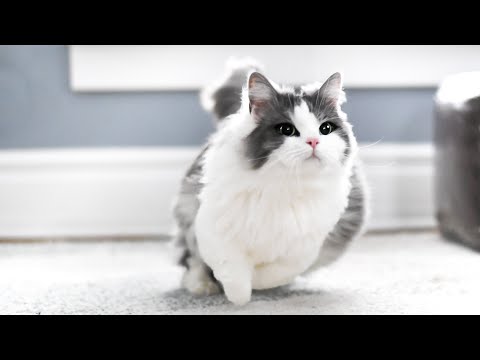The Munchkin Longhair is a recognized coat-length variant within the Munchkin breed and pairs a semi-long, silky coat with the breed’s signature short legs. TICA granted championship status in 2003, and this cat has a compact, moderate body that appeals to many families.
They weigh about 4–8 pounds for females and 6–9 pounds for males, and most live 12–15 years. Their playful, social personality makes them great for people who want daily interaction and lively company.
This buyer’s guide helps anyone who’s looking for a cuddly, long-coated companion understand looks, care, and how to shop responsibly. It previews grooming basics, health checks, and why breeder support and testing affect the price of a purebred pet-quality kitten.
Key Takeaways
- Recognized coat variant combines silky coat with short legs and a moderate body.
- Typical weight and lifespan help set realistic expectations for new owners.
- Playful, social temperament suits active households that offer daily play.
- Grooming, dental care, and nail routines keep the coat healthy and tangle-free.
- Research breeders, health testing, and pricing before choosing a kitten.
What Makes a Longhair Munchkin Different?
Certain Munchkin breeds are judged separately for their silky, semi-long coat while keeping the compact frame and very short legs that define the breed.
Breed basics: The Munchkin is a small-to-medium pet with a moderate body type and a dominant gene that shortens the legs. The semi-long coat gives a softer silhouette compared with the plush coat of the munchkin shorthair, but overall proportions and temperament stay the same.
Recognition and controversy
TICA accepted the breed for development in 1994 and granted championship status in 2003. Other cat associations, including some national registries and major world cat bodies, still decline recognition.
Debate in the cat fancy centers on welfare. Some organizations ban breeding, and policies vary between the international cat association members and national groups.
Sizes, weights, and lifespan in the United States
Typical adults in the United States usually weigh about 4–8 pounds for females and 6–9 pounds for males. They keep a balanced frame and medium rise from shoulder to rump.
With proper care most live about 12–15 years. Buyers should review official standards for coat length, legs, and body before evaluating individual kittens.
Temperament, Personality, and Daily Life
Playful and social, this small-statured companion shines in homes that offer daily interaction. Owners often report a bold, curious personality that seeks toys, puzzles, and human company.

Playful, social, and curious
They enjoy wand toys, puzzle feeders, and short training sessions. Many will follow their family from room to room and reward attention with affectionate antics.
Both the munchkin shorthair and munchkin longhair share the same temperament, so coat type rarely predicts energy or friendliness.
Mobility myths vs. reality
While their vertical leap is a shorter average than some other breeds, short-legged cats often sprint, turn tightly, and climb with surprising confidence.
“They may stand on their hind legs like little meerkats to get a better view.”
With stable perches and appropriately sized cat trees, these pets adapt well and integrate with respectful dogs and other cats after slow introductions. For people who ‘re looking for an active, social breed, they make lively, rewarding companions—while individual temperament still varies, so meeting a prospective kitten remains essential.
Grooming and Care for Munchkin Longhair
Regular grooming keeps a semi‑silky coat healthy and helps owners spot skin or dental issues early. A short, steady routine reduces mats and makes handling nails and teeth easier over time.

Brushing schedule and seasonal shedding
For the semi‑silky coat, daily or near‑daily brushing with a slicker or comb prevents tangles and controls shed. Seasonal de‑shedding sessions help remove loose undercoat and cut down on hairballs.
By contrast, a munchkin shorthair usually needs brushing once or twice weekly.
Bathing, nails, and dental care
Bath only as needed with a gentle, cat‑safe shampoo and dry thoroughly. Trim claws regularly and start short toothbrushing sessions when kittens arrive.
Tip: Pair brief grooming steps with treats and praise to build trust.
Home setup and enrichment
Place low, horizontal scratchers and sturdy trees with step platforms to suit short legs and body height. Daily interactive play with wand toys and puzzle feeders keeps joints strong and weight in check.
Health and Ethics: What Buyers Should Know
Potential owners must learn how a single dominant gene shapes both appearance and risk.
Genetics made simple
One autosomal dominant gene causes the shortened legs. Only heterozygous kittens are viable. Mating two affected adults can produce non‑viable embryos, so reputable programs avoid that pairing.
Common medical concerns
Reported health issues include lordosis, increased osteoarthritis risk, and pectus excavatum. Regular veterinary checks, weight control, and early orthopedic screening help manage these problems.
Registry, law, and controversy
The International Cat Association recognizes the breed, while several other major registries do not. There is much controversy in the cat fancy and bans in places like the Netherlands and parts of Australia.
Choosing responsible breeders
Ask breeders about outcrossing plans, orthopedic testing, and socialization. Request parentage proof, registration numbers, and a clear contract that includes health guarantees and return policies.
“A conscientious breeder supports the kitten and family well beyond pickup day.”
Tip: Prioritize welfare over price and seek lifelong support from the breeder.
Finding and Pricing a Long Hair Munchkin Cat
Expect price and availability to shift by region, pedigree, and the kitten’s coat and color. In the United States, buyers usually budget about $1,000–$2,000. That range reflects pedigree, show vs. pet quality, and breeder investment in testing and socialization.
What affects cost and what to expect
Price rises with documented lineage, health screens, and early vet care. Buyers paying more often get lifetime support, registration papers, and documented socialization.
Red flags: unusually low listings claiming a rare color, no contract, refusal to show the cattery, or no verifiable registration. These are common issues that precede problems.
Breeder vs. rescue and how to search
True pedigreed kittens are less common in shelters; many rescue animals resemble a breed without paperwork. Check TICA-affiliated breeders, request references, and verify social media updates and vet proof for litters.
“Document IDs, contracts, and payments, and walk away from pressure tactics.”
Be flexible about timing—litter availability and demand for certain colors or coat types vary. Set a total budget for the kitten, supplies, spay/neuter, and first-year care to avoid surprises.
Your Next Step to a Cuddly Companion
Before choosing a companion, buyers should confirm health tests, breeder practices, and daily care needs.
Check the International Cat Association or a trusted cat association for registry details and ask breeders for proof of screening. Learn how the dominant gene affects legs and what signs of joint discomfort, lordosis, or pectus excavatum to watch for.
Plan grooming for a semi‑silky coat length from day one and set up step-style climbing to protect short legs while keeping play active. Expect adults to weigh in the small-to-medium range and show a moderate body type.
Ask about outcross plans, socialization, return policy, and vet records. Take time, ask direct questions, and prioritize welfare—this helps families find a personality match that will reward them for years.




